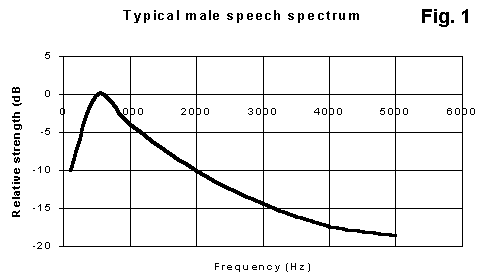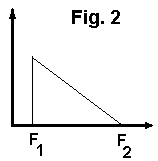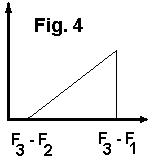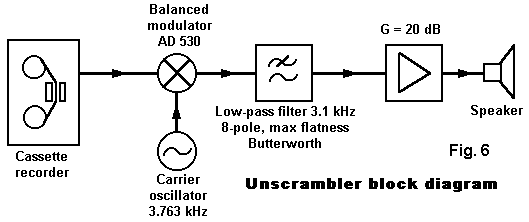
Based on an internal Kettering Group technical memo dated September 5, 1978

 This
audio spectrum is represented schematically by Fig.2
This
audio spectrum is represented schematically by Fig.2
Assume that the scrambling is done by audio spectrum inversion. This can be done by means of a balanced modulator and low-pass filtering. A balanced modultor is in essence an analog multiplier circuit.
If two sine-waves are multiplied the following is obtained:
![]()
i.e the sum and difference frequencies.
So, if an audio spectrum is multiplied by a constant carrier frequency to side-bands appear, but the carrier is suppressed (Fig.3):

A steep low-pass filter only transmits the signal below F3 and F3 is chosen so that he resulting spectrum falls within the original pass-band of the voice channel. Assume that F1=0.3 kHz and F2=3.3 kHz. Then F3-F2 must be equal to 0.3 kHz and F3=F2+0.3=3.6 kHz. The inverted audio spectrum transmitted by the Salyut voice transmitter and received and recorded on the ground is therefore (Fig. 4):

To unscramble this the spectrum inversion procedure is applied once more (Fig. 5) with the new carrier frequency F4:

If the resulting spectrum
is low-pass filtered around F4 and F4=F3
then the original audio spectrum is recreated, i.e. unscrambled.

The level from the tape recorder was 200 mV and the carrier oscillator level 5 V RMS at 3.763 kHz. The low-pass filter corner frequency was set at 3.1 kHz and the maximum flatness 8-pole Butterworth filer mode was selected (48 dB/octave roll-off). 20 dB additional gain was needed to drive the low impedance loudspeaker in series with a 40 ohm resistor. The setting of the carrier oscillator frequency is crucial, and the wrong setting results in a garbled audio signal much like the wrong BFO setting when receiving SSB. Otherwise the unscrambled voice sounds rather good considering the quickly assembled character of the unscrambling set-up.
".....With regards to space-to-earth communications, the author points out that flights lasting for months require increasingly frequent consultations between cosmonauts and medical specialists, and the cosmonauts often wish to keep their talks with physicians confidential. Therefore the station's communications system now includes a small instrument called 'Konvertor'. Its function is to 'invert' the frequency spectrum of ordinary speech. An analogous instrument is installed in the medical office of the Flight Control Center. By simply pushing a button, a cosmonaut can make his speech comprehensible only to the attending physician. It is noted that sometimes the cosmonauts also use this instrument to talk about 'domestic matters'...."
[begins in the middle of a phrase]
"... after taking Eunoctin (1). Are you clear about that? [pause] . ..
[Now a different voice] (Kovalyonok's probably because he mentions something his crewmate Sasha {=Alexander, i.e. Ivanchenkov} had said)
"I
have checked the cargo ship as well. On the cargo ship there is no...
There
is just the same Eunoctin. Although the medical kit on the cargo ship
should
have been put together considering our crew. Sasha made the same
observation.
I ask you to log this, for it was authorized with him, pass it up the
chain
of command and report it to the 19th tomorrow so that he would find
who's
responsible and that measures would be taken to them appropriately. Up
to the penalty! And inform us about the outcome. OK?"
![]()